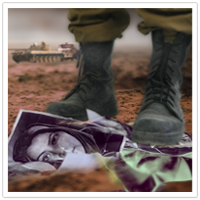Operation Eternal Light
Human Rights Watch
The MKO trained its fighters under the banner of the National Liberation Army (NLA)inside Iraq. The NLA established several military camps in Iraq and trained thousands ofguerrilla fighters to fight against the Iranian regime.
During the Iran-Iraq war, the NLA fighters regularly attacked Iranian troops along theIran-Iraq border and made several incursions into Iran. The largest operation by theNLA took place after Iran accepted U.N. resolution ۵۹۸, calling for a ceasefire between Iran and Iraq. Iran accepted the U.N. resolution on July ۱۸, ۱۹۸۸. The NLA forces, estimated at nearly ۷,۰۰۰ fighters, were immediately mobilized for an attack on Iran. Thisoperation was named Eternal Light.
The MKO’s leadership, believing that the Iranian government was weak and susceptibleto a popular uprising, reasoned that an incursion by the NLA forces would incite suchan uprising and would pave the way for their forces to march to Tehran and bring downthe government. On the eve of launching the operation, Masoud Rajavi told his troops:
We will not be fighting alone; we will have the people on our side. Theyare tired of this regime, and especially since the ceasefire, they haveevery incentive to get rid of it forever. We will only have to act as theirshields, protecting them from being easy targets for the [revolutionary]guards. Wherever we go there will be masses of citizens joining us, andthe prisoners we liberate from jails will help us lead them towardsvictory. It will be like an avalanche, growing as it progresses. Eventuallythe avalanche will tear Khomeini’s web apart. You don’t need to takeanything with you. We will be like fish swimming in a sea of people.They will give you whatever you need. ۱
On July ۲۴, ۱۹۸۸, the NLA fighters left their camps crossing the Iranian border atKhosravi checkpoint.۲ They initially met little resistance as they approached theprovincial capital of Kermanshah, nearly ۱۰۰ miles inside Iranian territory. But Iran’smilitary and Revolutionary Guard responded massively to defend Kermanshah, forcingthe NLA fighters to retreat towards the Iraqi border after suffering heavy losses.۳
According to Masoud Banisadr:
About ten years later, when the organization published names andphotographs of martyrs from the operation for the first time, thenumber of martyred was announced as ۱,۳۰۴. Our other losses wereofficially ۱,۱۰۰ injured, of whom ۱۱ subsequently died.۴
The NLA’s defeat was a defining moment for many of its fighters who realized theirmilitary might was far from sufficient to overthrow Iran’s government. “The level ofpessimism and lack of trust in Rajavi’s leadership was rising daily. Many were asking toleave the organization. Our broken spirits and injured bodies were a sign of the NLA’stactical and strategic defeat,” wrote Mohammad Reza Eskandari, another former MKOmember who was injured during the operation.۵
Masoud Banisadr also recalled the aftermath of the operation as a significant turningpoint for many MKO members:
Operation Forogh [Eternal Light] dashed our political hopes. Worse, itsignified the end of ideology, of moral belief and expectation –for meand, as I soon discovered, many others. Our basic values no longer hadany meaning and ceased to sustain us. We had all become actors playingto each other, encouraged by each other. This lie reached its intolerableclimax when our “ideological leader” failed to admit his predictions andjudgment had been wrong…once, we had been told that belief inMojahedin was based on two premises: the sacrifice they were willing tomake and their honesty. After Forogh the well of honesty completelydried up, and from then on the organization rested on only onefoundation: “sacrifice” and more “sacrifice.”۶
۱ Banisadr, Memoirs of an Iranian Rebel, p. ۲۸۳.
۲“Incursion by rebels threaten cease-fire,” The Washington Post, July ۳۰, ۱۹۸۸.
۳“Rebels routed in push for Tehran,” The Guardian, September ۶, ۱۹۸۸.
۴Banisadr, Memoirs of an Iranian Rebel, p. ۲۹۲.
۵Mohammad Reza Eskandari, Bar Ma Che Gozasht Khaterat Yek Mojahed (Paris: Kahvaran, ۲۰۰۴), p. ۸۳.
۶Banisadr, Memoirs of an Iranian Rebel, p. ۳۰۶.



